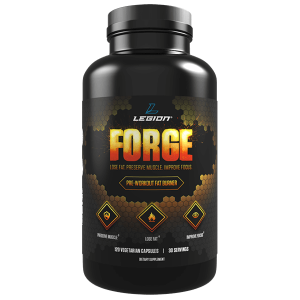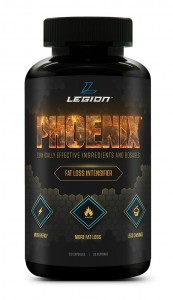Did you know that certain fat cells in your body are much harder to shrink than others?
And that they tend to accumulate in the belly, hip, and thigh regions (the areas last to get lean)?
Yup, there really is science behind the idea of “stubborn fat.” It’s 100% fact, not fiction.
There are also a handful of science-based diet, exercise, and supplementation strategies to help you lose stubborn fat faster.
They are…
- Make sure you’re in a large enough calorie deficit.
- Make sure you’re eating enough protein.
- Do heavy compound resistance training.
- Strategically use cardio to burn fat faster.
- Take the right fat loss supplements.
And in just a few minutes from now, you’re going to understand what those strategies are, why they work, and how to put them into play and see results in your first week.
Let’s start at the top.
Table of Contents
+
Want to listen to more stuff like this? Check out my podcast!
1. Make sure you’re in a large enough calorie deficit.
Research clearly shows that the only way to achieve significant fat loss is to eat less energy than you burn.
Yes, calories in vs. calories out matters. A lot.
(The number one reason people stop losing weight is terribly simple: overeating.)
When you eat fewer calories than you burn, you’re in a “calorie deficit” because, well, you’re feeding your body fewer calories than it needs.
And if you want to lose stubborn fat as quickly as possible, you need to ensure you’re in a large enough deficit.
Specifically, I recommend that you eat around 25% fewer calories than you burn every day.
That is, a 25% calorie deficit.
This will help you lose fat at a rapid clip without ever feeling starved or deprived.
Want to know how to figure out your calories? Check out this article.
2. Make sure you’re eating enough protein.
If there’s one thing most weight loss “gurus” agree about, it’s that a high-protein diet is best.
And they’re right.
Studies show that eating enough protein…
- Keeps you fuller on fewer calories
- Prevents muscle loss
- Increases energy expenditure
- Improves muscle recovery and repair
The bottom line is this:
If you don’t eat protein, you’re going to have a rough time losing weight, and particularly with losing fat and not muscle.
So, what’s enough protein?
Research shows that somewhere between 0.8 and 1.2 grams of protein per pound of body weight per day is optimal.
If you’re very overweight (25%+ body fat in men and 30%+ in women), then this can be reduced to around 1 gram of protein per pound of fat-free mass per day.
Want to know more about how much protein you need to eat and why? Check out this article.
3. Do heavy compound resistance training.
Your goal shouldn’t be to merely “lose weight.”
It should be to improve your body composition.
And that means that we want your body to burn as much fat and as little muscle as possible. That’s how we’re going to make sure you get lean and muscular, not skinny fat.
Using a proper calorie deficit and eating enough protein help with this, but heavy compound resistance training is the real linchpin.
The best way to preserve (or even gain!) muscle while losing fat is to follow a resistance training program that emphasizes heavy weights and compound exercises.
The reason for this is simple: as far as muscle goes, you either “use it or lose it.”
In other words, if you don’t want to lose your muscle when you diet (and just in general, really), you need to use it, and studies show that resistance training is best.
Want to know how to build an effective resistance training program? Check out this article.
4. Strategically use cardio to burn fat faster.

The best way to include cardio in a weight loss regimen is to do as little as needed to reach your desired rate of weight loss and stay fit, and no more.
For best results do . . .
- At least two low- to moderate-intensity cardio workouts per week of 20-to-40 minutes each.
- One HIIT workout per week if you enjoy it.
- No more than 2-to-3 hours of cardio per week.
- Cardio and weightlifting on separate days. If that isn’t possible, lift weights first and try to separate the two workouts by at least 6 hours.
Although you’ll often hear fitness gurus tout HIIT as the most effective kind of cardio for fat loss, this isn’t true. Moderate-intensity, steady-state cardio is just as good at fat-burning, easier to recover from, and doesn’t sap your motivation or energy as much as HIIT, which is why I recommend you do it for the majority of your cardio workouts.
5. Take the right fat loss supplements
I saved this for last because it’s the least important.
The truth is most fat loss supplements are worthless.
Unfortunately, no amount of weight loss pills and powders are going to make you lean.
Trust me. If you’re trying to lose fat, pill popping, even to excess, isn’t going to be enough.
Now the good news:
If you know how to drive fat loss with proper dieting and exercise, certain supplements can accelerate the process.
Based on my experience with my own body and with the thousands of people I’ve worked with, I feel comfortable saying that a proper fat loss supplementation routine can safely increase fat loss by about 30 to 50%.
That is, if you can lose 1 pound of fat per week through diet and exercise alone (and you can), you can lose 1.3 to 1.5 pounds of fat per week by adding the right supplements into the mix.
And here are those supplements:
3 to 6 mg of caffeine per kilogram of body weight per day
Caffeine increases the number of calories you burn and also boosts strength, muscle endurance, and anaerobic performance.
My preferred source of caffeine is a my pre-workout supplement PULSE.
0.1 to 0.2 milligrams of yohimbine per kilogram of bodyweight before exercising.
Yohimbine is a natural substance that accelerates fat loss by making it easier to mobilize and burn “stubborn” fat cells.
There’s a catch, though–research shows it only works when insulin levels are at a low, baseline level.
So that means you can only use it if you exercise in a fasted state.
The easiest way to do this is working out first thing in the morning, before you’ve had anything to eat.
If you do this, you’ll ensure that your insulin levels are low and that the yohimbine (and the other supplements I recommend) will be maximally effective.
Fasted training has other benefits, too.
Namely, it increases the amount of fat that you burn while working out and increases blood flow to “stubborn” fat regions like the stomach.
In terms of a specific yohimbine supplement to take, I recommend you check out my pre-workout fat burner FORGE.
Every serving contains clinically effective doses of yohimbine, HMB, and CDP-choline, which help you burn stubborn fat faster, preserve your muscle, and have better workouts.
Want to learn more about fasted training? Check out this article.
1 serving of PHOENIX per day.
PHOENIX is a fat burner that I developed.
It contains seven natural ingredients proven help you lose fat faster, including synephrine, naringin, and hesperidin.
Research shows that synephrine boosts metabolic rate, helps “target” stubborn fat cells for reduction, and increases the thermic effect of food.
Naringin and hesperidin work synergistically with synephrine to further increase its effectiveness.
The bottom line is if you want to lose fat faster without taking a bunch of stimulants or harsh chemicals, then you want to try PHOENIX.
Want to Know Even More About How to Lose Stubborn Fat Faster?
Implement these five stubborn fat loss strategies, and you’ll lean out faster.
I guarantee it.
If you’d like to know more about stubborn fat, though, and how to lose it as quickly as possible and keep it off for good, then I have a longer, more in-depth article for you to read:
4 Strategies for Losing Stubborn Fat for Good
What’s your take on how to lose stubborn fat? Have anything else to share? Let me know in the comments below!
Scientific References +
- Stohs, S. J., Preuss, H. G., Keith, S. C., Keith, P. L., Miller, H., & Kaats, G. R. (2011). Effects of p-synephrine alone and in combination with selected bioflavo-noids on resting metabolism, blood pressure, heart rate and self-reported mood changes. International Journal of Medical Sciences, 8(4), 295–301. https://doi.org/10.7150/ijms.8.295
- Haaz, S., Fontaine, K. R., Cutter, G., Limdi, N., Perumean-Chaney, S., & Allison, D. B. (2006). Citrus aurantium and synephrine alkaloids in the treatment of overweight and obesity: An update. In Obesity Reviews (Vol. 7, Issue 1, pp. 79–88). Obes Rev. https://doi.org/10.1111/j.1467-789X.2006.00195.x
- Gjedsted, J., Gormsen, L. C., Nielsen, S., Schmitz, O., Djurhuus, C. B., Keiding, S., Ørskov, H., Tønnesen, E., & Møller, N. (2007). Effects of a 3-day fast on regional lipid and glucose metabolism in human skeletal muscle and adipose tissue. Acta Physiologica, 191(3), 205–216. https://doi.org/10.1111/j.1748-1716.2007.01740.x
- Derave, W., Mertens, A., Muls, E., Pardaens, K., & Hespel, P. (2007). Effects of post-absorptive and postprandial exercise on glucoregulation in metabolic syndrome. Obesity, 15(3), 704–711. https://doi.org/10.1038/oby.2007.548
- Ostojic, S. M. (2006). Yohimbine: The effects on body composition and exercise performance in soccer players. Research in Sports Medicine, 14(4), 289–299. https://doi.org/10.1080/15438620600987106
- Beck, T. W., Housh, T. J., Schmidt, R. J., Johnson, G. O., Housh, D. J., Coburn, J. W., & Malek, M. H. (2006). The acute effects of a caffeine-containing supplement on strength, muscular endurance, and anaerobic capabilities. Journal of Strength and Conditioning Research, 20(3), 506–510. https://doi.org/10.1519/18285.1
- Astorino, T. A., Rohmann, R. L., & Firth, K. (2008). Effect of caffeine ingestion on one-repetition maximum muscular strength. European Journal of Applied Physiology, 102(2), 127–132. https://doi.org/10.1007/s00421-007-0557-x
- Astrup, A., Toubro, S., Cannon, S., Hein, P., Breum, L., & Madsen, J. (1990). Caffeine: A double-blind, placebo-controlled study of its thermogenic, metabolic, and cardiovascular effects in healthy volunteers. American Journal of Clinical Nutrition, 51(5), 759–767. https://doi.org/10.1093/ajcn/51.5.759
- Boutcher, S. H. (2011). High-intensity intermittent exercise and fat loss. In Journal of Obesity (Vol. 2011). Hindawi Publishing Corporation. https://doi.org/10.1155/2011/868305
- MacPherson, R. E. K., Hazell, T. J., Olver, T. D., Paterson, D. H., & Lemon, P. W. R. (2011). Run sprint interval training improves aerobic performance but not maximal cardiac output. Medicine and Science in Sports and Exercise, 43(1), 115–122. https://doi.org/10.1249/MSS.0b013e3181e5eacd
- Phillips, S. M. (2014). A Brief Review of Higher Dietary Protein Diets in Weight Loss: A Focus on Athletes. In Sports Medicine (Vol. 44, Issue Suppl 2, pp. 149–153). Springer International Publishing. https://doi.org/10.1007/s40279-014-0254-y
- Brehm, B. J., & D’Alessio, D. A. (2008). Benefits of high-protein weight loss diets: Enough evidence for practice? In Current Opinion in Endocrinology, Diabetes and Obesity (Vol. 15, Issue 5, pp. 416–421). Curr Opin Endocrinol Diabetes Obes. https://doi.org/10.1097/MED.0b013e328308dc13
- Hill, J. O., Wyatt, H. R., & Peters, J. C. (2012). Energy balance and obesity. Circulation, 126(1), 126–132. https://doi.org/10.1161/CIRCULATIONAHA.111.087213












